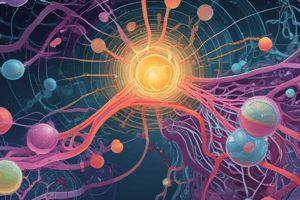Podcast
Questions and Answers
What is the primary function of metabolism in a cell?
What is the primary function of metabolism in a cell?
- To degrade all substances
- To maintain homeostasis and produce necessary substances (correct)
- To solely generate energy
- To only synthesize proteins
Which term describes the process of breaking down larger molecules into smaller ones?
Which term describes the process of breaking down larger molecules into smaller ones?
- Anabolism
- Photosynthesis
- Catabolism (correct)
- Metabolism
Which category of nutrients do autotrophs primarily uptake?
Which category of nutrients do autotrophs primarily uptake?
- Amino acids
- Organic carbon compounds
- Inorganic carbon dioxide (correct)
- Glucose
What distinguishes facultative anaerobes from obligate anaerobes?
What distinguishes facultative anaerobes from obligate anaerobes?
What is the primary role of ATP in cellular metabolism?
What is the primary role of ATP in cellular metabolism?
What process converts ADP and inorganic phosphate into ATP?
What process converts ADP and inorganic phosphate into ATP?
What part of an enzyme is described as the protein part?
What part of an enzyme is described as the protein part?
Which type of enzyme specificity is only directed towards a particular chemical reaction?
Which type of enzyme specificity is only directed towards a particular chemical reaction?
Flashcards
Metabolism
Metabolism
Sum of all chemical reactions that happen inside a cell to sustain life. It includes energy transfer, production of essential molecules, and removal of waste products.
Catabolism
Catabolism
Processes that break down larger molecules into smaller ones, releasing energy in the process. This energy is used for other cellular activities.
Anabolism
Anabolism
Processes that build larger molecules from smaller ones, requiring energy input. This energy is often obtained from catabolism.
ATP (Adenosine Triphosphate)
ATP (Adenosine Triphosphate)
Signup and view all the flashcards
Phosphorylation
Phosphorylation
Signup and view all the flashcards
Dephosphorylation
Dephosphorylation
Signup and view all the flashcards
Enzymes
Enzymes
Signup and view all the flashcards
Chemotrophs
Chemotrophs
Signup and view all the flashcards
Study Notes
Cellular Metabolism
- Metabolism: Chemical reactions in cells, maintains homeostasis, produces needed substances, breaks down waste, and facilitates growth.
- Primary Level: Essential processes for energy production and basic cell functions (e.g., protein synthesis, DNA synthesis, photosynthesis).
- Secondary Level: Processes built on primary processes, including pigment metabolism.
- Catabolism: Large molecules broken down into smaller molecules, releasing energy.
- Anabolism: Smaller molecules combined to form larger molecules, requiring energy.
- Material Metabolism: Involves substance absorption, transformation, and release.
- Energy Metabolism: Conversion of different energy types, storage, and release.
- Phototrophs: Organisms creating their own energy, mostly green plants.
- Chemotrophs: Organisms utilizing energy from chemical bonds.
- Autotrophs: Organisms obtaining carbon from inorganic sources (like CO2).
- Heterotrophs: Organisms obtaining carbon from organic sources (like glucose).
- Aerobic: Organisms needing oxygen for life processes.
- Anaerobic: Organisms living without oxygen.
- Facultative Anaerobic: Organisms that can function with or without oxygen.
Transport of Energy in a Cell
- ATP (Adenosine Triphosphate): Cellular energy carrier molecule with high-energy bonds.
- ATP creation: Occurs via aerobic respiration (mitochondria) or anaerobic respiration (cytoplasm). Glycolysis is a cytoplasmic process.
- Energy for other functions: ATP provides energy for movement and processes like bioluminescence in some organisms (e.g., mushrooms).
- Phosphorylation: ADP gains a phosphate group to become ATP.
- Dephosphorylation: ATP releases a phosphate group to become ADP.
Enzymes
- Enzymes: Protein catalysts.
- Apoenzyme: Protein portion of an enzyme.
- Coenzymes: Non-protein portion of an enzyme.
- Cofactors: Non-protein accessory components for enzyme function.
- Specificity: Each enzyme catalyzes a specific chemical reaction.
- Functional Enzymes: Enzymes for specific chemical reactions, e.g., dehydrogenases.
- Substrate Specificity: Enzymes catalyze the reaction only on certain substrates, e.g., glucose elimination.
Studying That Suits You
Use AI to generate personalized quizzes and flashcards to suit your learning preferences.




